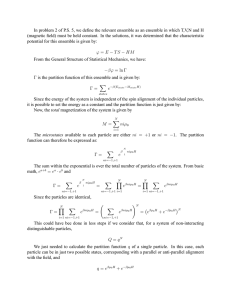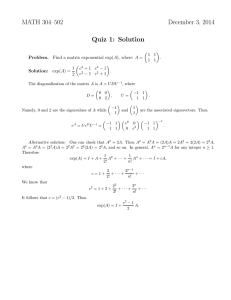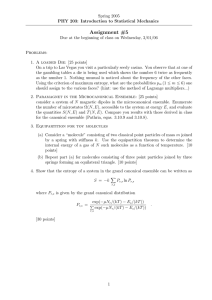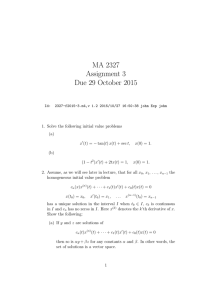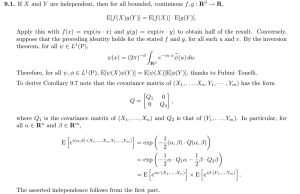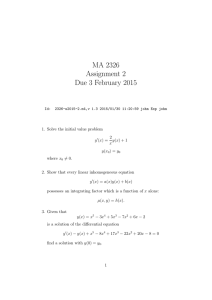Recitation: 11/06/03
advertisement
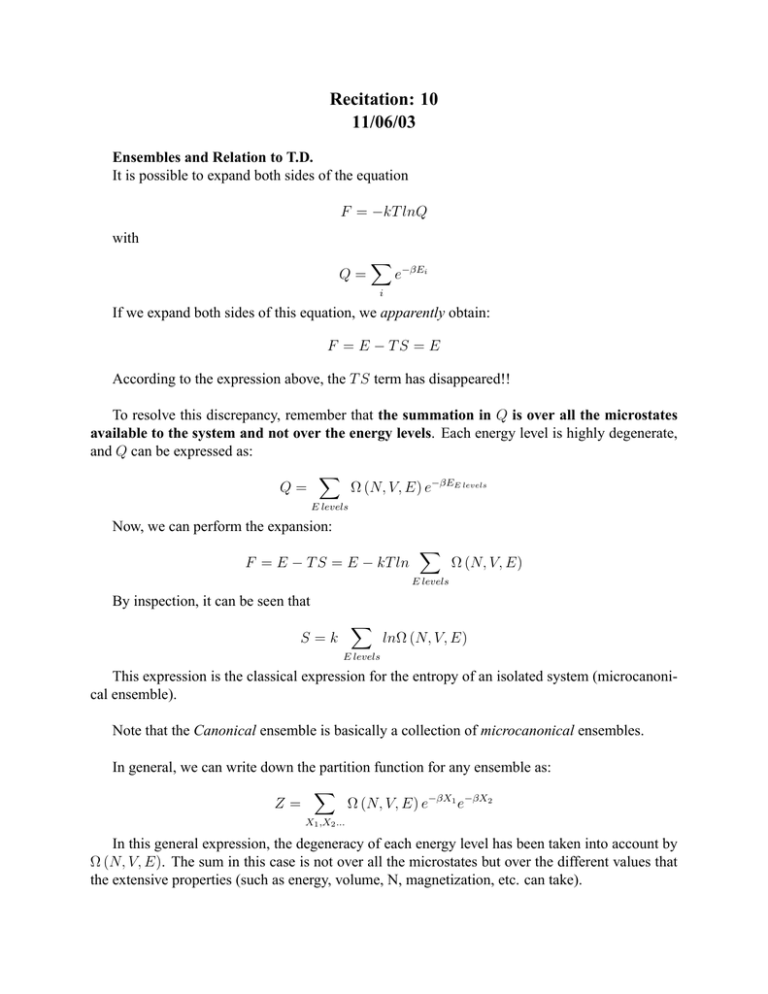
Recitation: 10
11/06/03
Ensembles and Relation to T.D.
It is possible to expand both sides of the equation
F = −kT lnQ
with
Q=
�
e−βEi
i
If we expand both sides of this equation, we apparently obtain:
F = E − TS = E
According to the expression above, the T S term has disappeared!!
To resolve this discrepancy, remember that the summation in Q is over all the microstates
available to the system and not over the energy levels. Each energy level is highly degenerate,
and Q can be expressed as:
�
Ω (N, V, E) e−βEE levels
Q=
E levels
Now, we can perform the expansion:
F = E − T S = E − kT ln
�
Ω (N, V, E)
E levels
By inspection, it can be seen that
�
S=k
lnΩ (N, V, E)
E levels
This expression is the classical expression for the entropy of an isolated system (microcanoni­
cal ensemble).
Note that the Canonical ensemble is basically a collection of microcanonical ensembles.
In general, we can write down the partition function for any ensemble as:
�
Z=
Ω (N, V, E) e−βX1 e−βX2
X1 ,X2 ...
In this general expression, the degeneracy of each energy level has been taken into account by
Ω (N, V, E). The sum in this case is not over all the microstates but over the different values that
the extensive properties (such as energy, volume, N, magnetization, etc. can take).
For more details, see Hill, p. 30
Fluctuations
In Statistical Mechanics, the mechanical variables (those variables that can be explicitly de­
fined for each of the microstates accessible to the system) fluctuate around their average (or most
probable) value with a characteristic spread, which is a function of the actual boundary conditions
of the system under study.
Depending on the boundary conditions (i.e. ensemble) used, different mechanical properties
fluctuate.
It is important to answer to these two questions:
• How big are fluctuations of mechanical properties?
• Does the relative size of the fluctuations offer new information?
In general, the spread of the distribution for the values of the instantaneous mechanical prop­
erties around their average values is given by:
�
�2
2
2
σM
= M − M = M2 − M
In class, we saw a three­step procedure to obtain the fluctuation of a mechanical variable:
Given the explicit equation for the average value for a mechanical property M :
�
M=
Mν Pν
ν
1) Multiply both sides by the partition function of the ensemble:
�
MZ =
Mν Pν Z
ν
2) Take the derivative of the equality with respect to the conjugate variable of the fluctuating
mechanical variable.
3) Divide both sides by the partition function and re­arrange.
In general, the spread for extensive mechanical variables is very small for large systems (N ∼
10 ):
σM
1
∼√
M
N
There are some cases, however, when fluctuations are not negligible:
23
• Small Systems
• Critical Points
Applications of Statistical Mechanics to Specific Systems
In general, the partition function for a statistical mechanical ensemble (in this case the Canon­
ical Ensemble) is given by:
�
e−βEν
Q=
ν
For systems of non­interacting particles, it is possible to write their partition function in an
explicit manner.
Examples of these systems:
• Ideal Gas
• Electrons in a periodic crystal
• Photon Gas
• Lattice Vibrations
Distinguishable Particles
For non interacting particles, we saw in class that the total energy of the system can be ex­
pressed as:
b
ET = εal + εm
+ εnc + · · ·
where εal is the energy of particle a in microstate l.
If the particles are non­distinguishable, the partition function is very easy to evaluate:
�
���
a
b
c
e−βEν =
Q=
· · · e−β (εl +εm +εn +···)
ν
Q=
�
�
m
n
� l�
� �
�
�
�
a
b
c
e−βεl ·
e−βεm ·
e−βεn · · ·
m
l
n
Q =
qa · qb · qc · · ·
If all the particles are identical, qa = qb =
qc · · · :
Q = qN
where
q=
�
e−β�l
l
where l is the subindex corresponding to each of the microstates accessible to each of the particles
comprising the system.
Non­distinguishable Particles
When the system is composed of non­interacting, non­distinguishable particles, the unrestricted
sum:
�
���
a
b
c
Q=
e−βEν =
· · · e−β (εl +εm +εn +···)
ν
m
l
n
has to be corrected.
For fermions, there cannot be two particles in the same microstate:
εal + εbl + εnc + · · · → violates Pauli
For bosons:
b
c
d
a
c
d
εal + εm
+ εm
+ εm
↔ εm
+ εbl + εm
+ εm
Over counting N times
N (N − 1)
c
d
b
εal + εbl + εm
+ εm
↔ εam + εm
+ εcl + εld Over counting
times
2
b
c
εal + εm
+ εnc + εod ↔ εoa + εbl + εm
+ εnd
Over counting N !times
When the number of states available is much greater than the number of particles in the system
Φ (E) >> N , the last term dominates the sum, and the partition function can be approximated
as:
qN
Q=
N!
This is usually the case for:
• High Temperatures
• Low Density
• Large Mass
Problem 1
Consider the isothermal­isobaric ensemble, for which the partition function is
�
Δ=
e−βEi −βpVj
i,j
For this ensemble, calculate the standard deviation σV of the volume, as a fraction of the total
volume of the system.
Solution 1
We know that
σV2 = V 2 − V
2
In order to calculate the fluctuation for the volume in this ensemble, we follow the procedure
seen in class:
First, we write the explicit equation for the average volume in this ensemble:
�
Vj e−βEi −βpVj
i,j
V¯ =
Δ
1) Multiply both sides of the equality by the partition function Δ:
�
V¯ · Δ =
Vj e−βEi −βpVj
i,j
2) Take the derivative of both sides with respect to the conjugate variable for V , in this case, we
define the conjugate variable as γ = βp:
�
�
�
∂
Vj e−βEi −γVj
�
�
i,j
∂ V̄ · Δ
=
∂γ
∂γ
�
¯
∂V
∂Δ
Δ + V¯
=−
Vj2 e−βEi −γVj
∂γ
∂γ
i,j
�
�
� −βEi −γVj
∂
e
�
i,j
∂V¯
Δ + V¯
=−
Vj2 e−βEi −γVj
∂γ
∂γ
i,j
�
�
∂V¯
Δ − V̄ ·
Vj e−βEi −γVj = −
Vj2 e−βEi −γVj
∂γ
i,j
i,j
3) Divide both sides by the partition function:
∂V¯
2
− V = −V 2
∂γ
p
From this we finally obtain (here we have expanded γ = kT
):
�
�
∂V
2
2
2
σV = V − V = −kT
∂p T ,N
Using the definition for the isothermal compressibility, we have:
σV2 = kT V κT
The normalized standard deviation of the volume is given by:
�
kT κT
(kT V κT )1/2
σV
=
=
V
V
V
For an ideal gas, κT =
1
p
and we have:
σV
=
V
�
kT
=
PV
�
kT
1
=√
N kT
N
Problem 2
Consider a system of N distinguishable non­interacting spins in a magnetic field H. Each spin
has a magnetic moment of size µ, and each can point either parallel or anti­parallel to the field.
The magnetic moment is given by ni µ where ni = +/ − 1. Note that since the system is made
of non­interacting particles, the total energy of the system does not depend on the arrangements of
the spins, i.e. the energy is constant.
(a) Determine the internal energy of this system as a function of β, H, and N by employing an
ensemble characterized by these variables.
(b) Determine the entropy of this system as a function of β, H, and N.
(c) Determine the behavior of the energy and entropy for this system as T → 0.
Solution 2
The magnetization is given as
M=
N
�
n i µo
i=1
•This is basically saying that we have atoms localized in a crystal and the magnetic moment at
each site can be either up or down. The problem asks us to determine the thermodynamic properties
as a function of T, N, H. Let us also assume for simplicity that we can work at constant volume.
Therefore, our controlling variables are T, N, V, H.
•We need to make the appropriate Legendre transform to the entropy. Remember the entropy
can be written starting from E:
E = T S − pV + HM + µN
rearranging to get things in terms of S and β we get
S
= βE + βpV − βHM − βµN
k
Legendre transform such that our controlling variables are V, N, T, H
S
− βE + βHM = β(T S − E + HM ) = −βψ = ln Γ
k
where ψ is the characteristic potential for this ensemble with V, N, T, H constant and Γ is
the partition function. Γ can be written as
Γ =
�
states
exp [−β (Estate − Mstate H)]
where we sum over all possible energy states and magnetizations Mstate.
•Since the particles are non­interacting, the energy at N, β = constant and H = 0 is constant.
E is independent of the number or arrangement of up versus down spins. Since the absolute scale
of energy is not important for thermodynamics, we can arbitrarily set the constant energy equal to
zero giving us
Γ=
�
exp [βMstate H] =
states
�
�
exp β
n1 ,n2 ,...nN
Γ=
�
N
�
N
�
�
n i µo H =
N
�
exp [βni µo H]
n1 ,n2 ,...nN i=1
i=1
exp [βni µo H] =
n1 ,n2 ,...nN i=1
�
N �
+1
�
exp [βni µo H]
i=1 ni =−1
We can evaluate the sum since ni = ±1 so,
Γ = (exp [βµo H] + exp [−βµo H])N
We know the characteristic potential of an ensemble is related to the partition function for that
ensemble according to
−βψ = ln Γ → ψ = −kT ln Γ
Furthermore, we know from thermo that
dψ = −SdT − pdV + µdN − M dH
which gives us the following relationships for the properties of the system:
�
S = −
�
∂ψ
∂T
�
V,N,H
�
∂ψ
M = −
∂H V,N,T
�
�
∂ψ
µ =
∂N V,T,H
�
�
∂ψ
p = −
∂V T ,N,H
and from stat mech we have from above
ψ = −kT N ln [exp [βµo H] + exp [−βµo H]]
•Lets get the entropy, S
�
S=−
�
∂ψ
∂T V,N,H
�
�
− µkTo H2 (exp [βµo H] − exp [−βµo H])
S = kN ln (exp [βµo H] + exp [−βµo H]) + kT N
exp [βµo H] + exp [−βµo H]
S = kN {ln (exp [βµo H] + exp [−βµo H]) − βµo tanh (βµo H)}
•Now for the magnetization
�
M =−
�
�
�
∂ψ
exp [βµo H] − exp [−βµo H]
= kT N βµo
= N µo tanh (βµo H)
∂H V,N,T
exp [βµo H] + exp [−βµo H]
M = N µo tanh (βµo H)
•
The energy E
ψ = E − T S − HM
E = ψ + T S + HM = 0
•However if you define a quantity called the internal magnetic energy (which is a quantity
analogous to the enthalpy in the T, p, N ensemble)
EH = E − HM
you can get
EH = −N µo H tanh (βµo H)
•The last part of this problem asks you to determine the behavior of the energy and entropy as
T →
0.
EH (T → 0) = −N µo H
lim S = lim kN {ln (exp [βµo H] + exp [−βµo H]) − βµo tanh (βµo H)} = 0
β→∞
β→∞
S(T → 0) = 0 is in accordance with the third law of thermodynamics.
